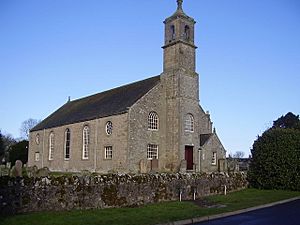Eccles, Scottish Borders facts for kids
Eccles is a small village and farming area in the Scottish Borders region of Scotland. It's located near the town of Kelso in Berwickshire. The village is connected to two other nearby villages, Birgham and Leitholm.
Contents
What's in a Name?
The name Eccles comes from an old British word, eglwys, which means 'church'. This word is still used in the Welsh language today. It originally came from the Latin word ecclesia, also meaning 'church'. Many places in Britain with 'Eccles' in their name likely had an early church.
A Glimpse into History
Early Christian Times
People believe that Eccles was a Christian settlement as early as the 500s. Places named 'Eccles' often show where ancient Christian sites were located.
The Cistercian Convent
In 1156, a special place called St. Mary's Cistercian convent was founded in Eccles. It was built by Gospatric, Earl of Dunbar, or perhaps his wife. A convent is a community where nuns live and worship.
Challenges and Changes
The convent faced tough times. In 1545, forces led by the Earl of Hertford burned it down. After this, the land was given to the Home family. Today, only a few old parts of the convent remain, like two small, barrel-shaped rooms. Some old stones from the convent might even be part of the current parish church.
Important Burials
A famous person named Patrick I, Earl of Dunbar, who was a powerful earl, was buried at the Eccles convent when he died in 1232.
Local Landowners
In the past, important families owned much of the land around Eccles. In 1696, George Home of Kames was a major landowner. Another important family lived at Purves Hall, and Simon Marjoribanks lived at Stainrig. Later, in 1843, James Greig lived at Eccles House, which is right next to the village.
The Eccles Church
Building and Design
The main church in Eccles, part of the Church of Scotland, was rebuilt in 1774. It's a large building with five sections. It has pretty stained glass windows, including a special 'War Memorial Window'. The church also has a unique bell-tower at one end with a bell from 1659. The inside of the church was last updated in 1930.
Past Ministers
The first known Presbyterian minister at Eccles was Robert French, who served from 1567 to 1574. Later, in 1691, Reverend John Lauder became the minister. Some people tried to stop his ceremony, but he still took the role. He was an important member of the General Assembly in 1692. Reverend Lauder was sometimes sent to preach in other areas. He was followed by Reverend Matthew Dysart, who served the church for a very long time – 43 years!
Today's Parishes
Today, the Eccles church parish is joined with the parishes of Birgham and Leitholm.
Famous People from Eccles
Eccles has been home to some notable individuals:
- Henry Home, Lord Kames: A very famous Scottish judge and philosopher.
- William Baird (physician) (1803-1872): A doctor and zoologist (someone who studies animals).
- William Barron (1805-1891): A skilled landscape gardener and park designer, who was born here.
- Thomas Creak Craik: An early modern farmer who owned Whitrig Farm and helped fund the building of a new church in Temple Village in 1832.


